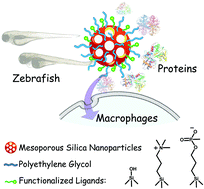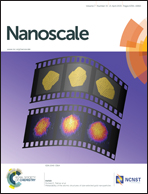Biosafety evaluations of well-dispersed mesoporous silica nanoparticles: towards in vivo-relevant conditions†
Abstract
This study aimed to investigate how mesoporous silica nanoparticles (MSNs), especially focussing on their surface functional groups, interacted with Raw 264.7 macrophages, as well as with zebrafish embryos. Upon introducing nanoparticles into a biological milieu, adsorption of proteins and biomolecules onto the nanoparticle surface usually progresses rapidly. Nanoparticles bound with proteins can result in physiological and pathological changes, but the mechanisms remain to be elucidated. In order to evaluate how protein corona affected MSNs and the subsequent cellular immune responses, we experimented in both serum and serum-deprived conditions. Our findings indicated that the level of p-p38 was significantly elevated by the positively charged MSNs, whereas negatively charged MSNs resulted in marked ROS production. Most significantly, our experiments demonstrated that the presence of protein efficiently mitigated the potential nano-hazard. On the other hand, strongly positively charged MSNs caused 94% of the zebrafish embryos to die. In that case, the toxicity caused by the quaternary ammonium ligands on the surface of those nanoparticles was exerted in a dose-dependent manner. In summary, these fundamental studies here provide valuable insights into the design of better biocompatible nanomaterials in the future.


 Please wait while we load your content...
Please wait while we load your content...